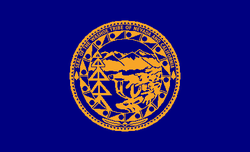Washoe people are the only Great Basin tribe whose language is not Numic, so they are believed to have inhabited the region prior to neighboring tribes. The Kings Beach Complex that emerged about 500 CE around Lake Tahoe and the northern Sierra Nevadas are regarded as early Washoe culture. The Martis complex may have overlapped with the Kings Beach culture, and Martis pit houses gave way to conical bark slab houses of historic Washoe culture. The Washoe people and the neighboring Northern Paiute people were culturally and linguistically very different, and these two tribes were sometimes in conflict.
Washoe people may have made contact with Spanish explorers in the early 19th century, but the Washoe did not sustain contact with people of European culture until the 1848 California Gold Rush. Washoe resistance to incursions on their lands proved futile, and the last armed conflict with the Washoes and non-Indians was the Potato War of 1857, when starving Washoes were killed for gathering potatoes from a European-American farm near Honey Lake in California.
Loss of the valley hunting grounds to farms and the piñon pine groves to feed Virginia City's demand for lumber and charcoal drove most Washoe to dependency on jobs on white ranches and farms and in cities. The areas where they settled became known as Indian colonies.
Washoe people have lived in the Great Basin and the eastern Sierra Nevada mountains for at least the last 6,000 years, some say up to 9,000 years. Prior to contact with Europeans, the territory of the Washoe people centered around Lake Tahoe and was roughly bounded by the southern shore of Honey Lake in the north, the West Walker River, Topaz Lake, and Sonora Pass in the south, the Sierra Nevada crest in the west, and the Pine Nut Mountains and Virginia Range in the east. Beside Lake Tahoe the Washoe utilized the upper ranges of the Carson, Truckee, and West Walker rivers to the east as well the Sierra Valley. The Washoe would generally spend the summer in the Sierra Nevada, especially at Lake Tahoe; the fall in the ranges to the east; and the winter and spring in the valleys between them. Washoe Lake was named after them.
